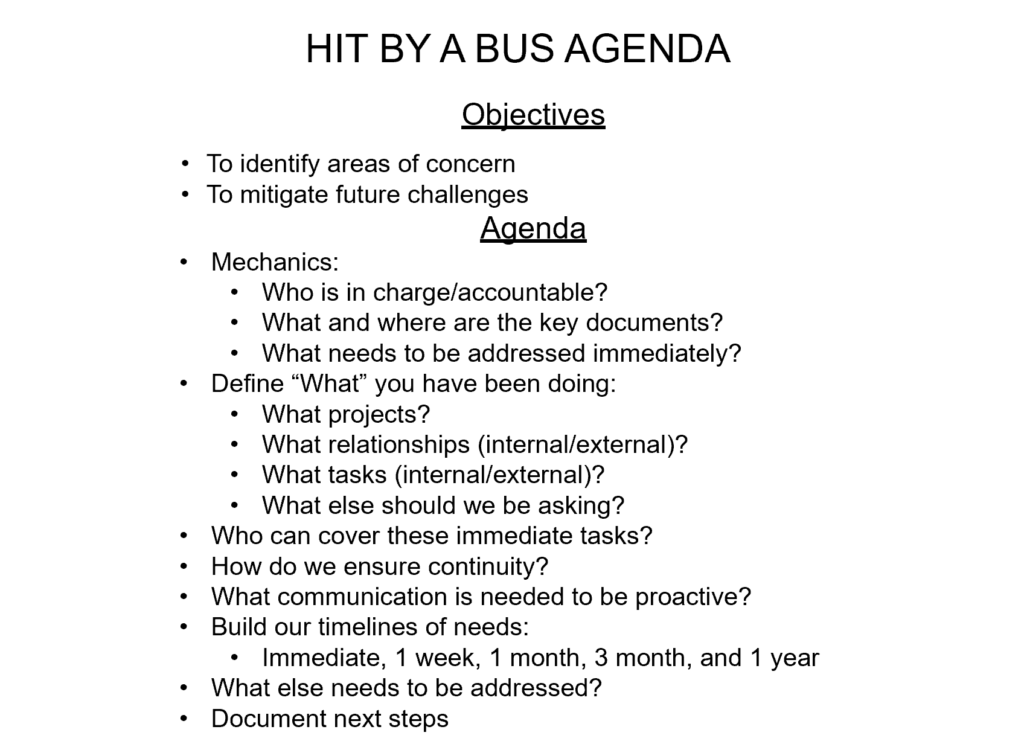Blog #201
In my last blog, #200, I outlined a high-level workshop I do with leadership teams that is designed to get the team thinking about identifying and documenting continuity challenges they would face if any one of them was “Hit by a Bus”. This blog describes a more specific exercise and the impact it can have when talking about the sudden absence of a CEO and/or owner.
For this task, the CEO and I agree in advance to this exercise and we prep accordingly. In some cases, it may include an in-depth review of any existing buy-out agreements, business insurance plans, and discussing who should attend the session. Typically, we plan to complete this exercise during a quarterly offsite strategy session, though it can be done any time in a separate, special session. Most offsite quarterlies last around eight hours, so it’s vital for members of the leadership team to plan ahead.
When the session starts, those present will notice that the CEO is not there…and they know the CEO is never late. I then ambush the team by announcing, “The CEO is fine and 100% healthy, but for this exercise, we’re going to assume that she was hit by a bus last night and is no longer with us. We’re going to take the first four hours and work on what that looks like and what needs to be addressed.” After hearing this, there is usually a bit of bewilderment, nervous laughter, and sometimes a few very knowing glances of concern. If a spouse or relative is going to be the person who will inherit the business or if an estate attorney is involved, it may be a good idea for them to join the meeting.
From here, the next three to four hours are designated for smoking out all the items we can think of that need to be addressed. We then begin outlining a possible continuity plan. Here is a version of the agenda I follow:

Obviously, this dramatically changes the group dynamic. However, it’s also a great forcing mechanism to uncover issues, and to define and address possible challenges before it is actually needed. None of these things are anything people like to talk about, but it is the fiduciary obligation of the team to have these conversations.
Some major curveballs may come into play when a team realizes they are now suddenly working for an owner’s spouse or children – a reality that they had no idea was coming. In some cases, we may have to create an employee retention bonus/plan. Other areas may be associated with establishing and building key relationships. A sudden change could put key clients, vendors, and employees at risk for being lost.
I believe the three biggest benefits to come out of these sessions are as follows:
- Peace of mind. In other words, acknowledging it is possible, but when addressed, it can be a challenging, but reasonable transition.
- Finding the gaps. Once we identify the blind spots and gaps, we can begin to identify and build a plan to avoid and fill them.
- Ensure continuity. Filling the gaps and building a continuity plan is an obligation of the leadership team.
There is a lot more to it, but this gives everyone a good idea of where to start. The key is to keep asking questions and documenting issues, challenges, and opportunities. Get them all out and captured, and this in and of itself can be of great value. If you do it now, when you are not emotionally charged, you can begin building a plan to address the future.
Ideally, you will never need this plan. However, I am guessing that even if you don’t ever get “hit by a bus,” every organization could benefit from completing this exercise.
Do you have a continuity plan in place? Need some help creating one? We can help with that! Contact us today to learn more.





